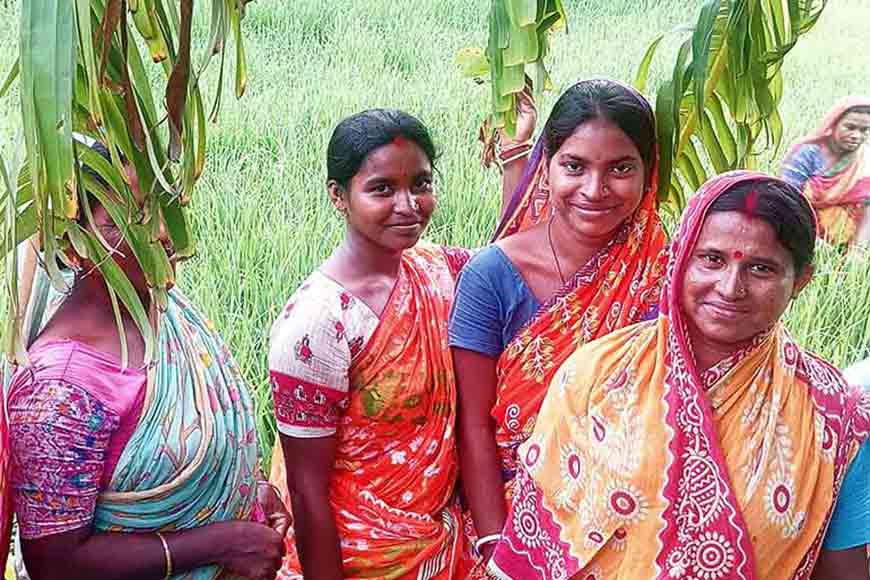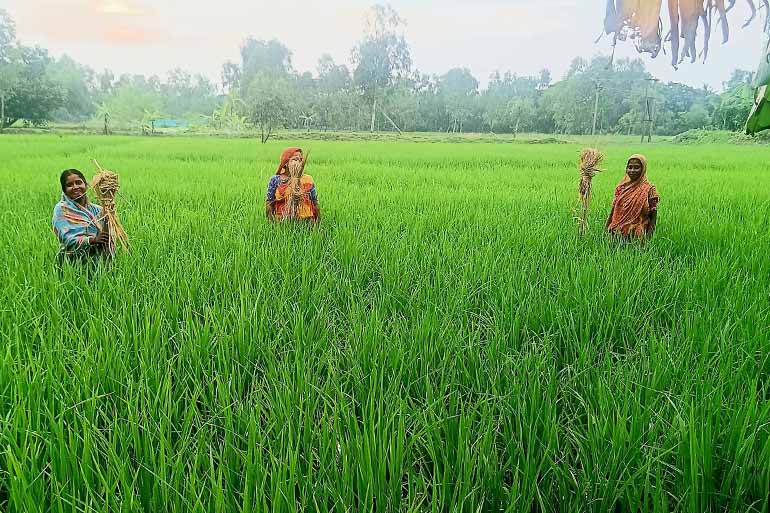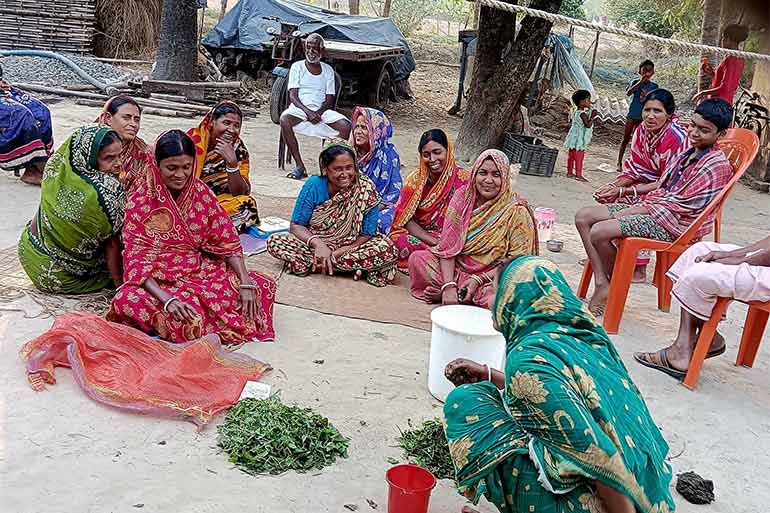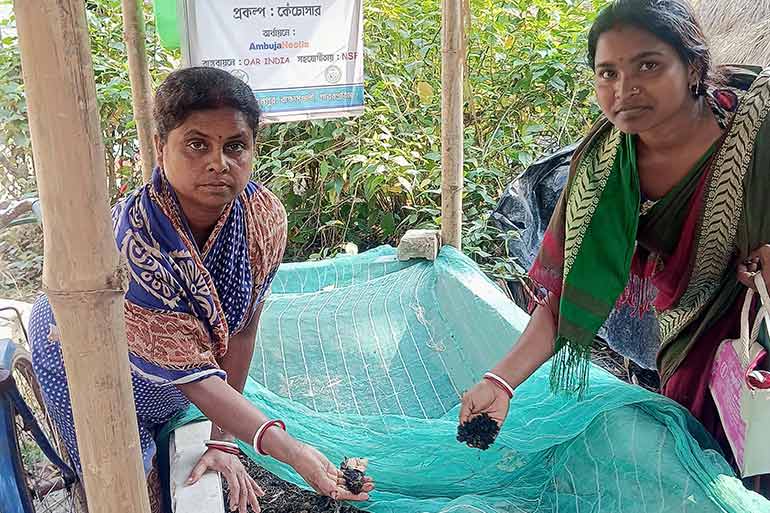Sundarbans Women Cultivate Hope through Organic Farming - GetBengal Story

Dense black clouds hover in the sky, intermittently showering steady rainfall, and while gazing at the developing saplings soaked in rainwater, one could easily make the observation—without so much as a flip in the pages of the Bengali calendar— that it is the monsoon season. It is the general awareness that Asharh, the first month of the Bengali monsoon, is when the Earth is fertile—and therefore it is the month of plenty. This is the season when nature grows green and lush and bountiful. Science explains this, saying that soil fertility is largely dependent on geography, which means that the climate and weather of particular areas make it suitable to grow particular crops. Nonetheless, the continuing pressure of the human population demands more from the land; it demands more and more crops, more and more production.
As a result of this human strain, different chemicals are slowly interspersing into the soil that is causing Earth to lose its intrinsic fertility. It is at this point that women in the periphery of South 24 Parganas are tenderly embracing the soil, observing organic fertilizers for growing golden crops even in salt-affected cultivated soil. Under their gentle hand, waves of sea air from the Bay of Bengal jitter upon paddy fields. Fields are flourished with different varieties of rice such as Swarnachur, Dudheshwar, Patnai, Dhanurban, and there is even aromatic Gobindobhog production in the region.

But in a region nearly bordering the Bay of Bengal, does rice cultivation require any special preparation? On this matter, Amrita Das, a woman farmer from Sundarban G-Plot, told Bongdarshan.com, “Our soil here is mostly saline, so we cultivate rice varieties suited to this type of soil. However, some lands have slightly higher salt content. In those areas, we apply organic fertilizers to make the soil suitable for rice cultivation before planting.” She mentioned that the villagers make these organic fertilizers themselves using composts from cow dung, vermicompost, and other materials and spreading them on the field. They grow rice and also vegetables and other crops.
In an era in which chemical use is nearly universal, why does agriculture in this area rely so heavily on organic fertilizer? Amrita explained that using organic fertilizers prevents soil pollution, costs less, ensures healthy crops, and maintains the nutritional quality of food. Therefore, women in the villages are trained to make these fertilizers. Beyond fertilizers, they have also adopted organic methods for pest control. The training for preparing these fertilizers and organic pesticides is provided by the Development Research Communication and Service Center (DRCSC). In addition, the women receive various government aids to assist with cultivation.

Farming is traditionally considered hard labor, mainly associated with men, yet in this region, many women are directly involved in agriculture. Another woman farmer, Suchanda Bhuiya, told Bongdarshan .com, “Here, whether it is our family or any other household in the neighborhood, there is no distinction between men and women in terms of work. We all cooperate with nature’s forces, working with the ecology to develop the land."
The primary concern in the agricultural economy in the Sundarbans is how to recover from natural disasters. With strong cyclone activity occurring frequently within the coastal region of the Bay of Bengal, cyclone disasters can be responsible for significantly damaging agricultural production. Flooding can also deposit seawater that increases salinity in the soil. In the meantime, lime, mustard husk and other materials were put into the fields to reduce salinity and make land productive again. A memorable event was Cyclone Aila in 2009 which changed the socio-economic circumstances of the Sundarbans. As Raju Gopal Mondal, a Sundarbans local said, "Even 15 years later. the damage in Aila is still not compensated". Most villagers previously relied primarily on agriculture and fishing. But Aila changed the character of the land, making it impossible to survive on farming alone, forcing most men to seek work elsewhere. As a result, women have increasingly focused on agriculture.”
Another distinction of rice cultivation in Sundarbans compared to other districts is in crop marketing. In other districts, rice is largely grown for commercial purposes. In Sundarbans, most crops are grown to meet the household’s yearly food needs. Surplus crops are then sold in the market. Prices vary depending on the type of rice—for example, Dudheshwar rice sells for around 1,500 rupees per sack, whereas Gobindobhog, an aromatic rice, can fetch over 2,000 rupees per sack. However, such aromatic rice is primarily cultivated for commercial purposes, Suchanda noted.

It is as if nature itself takes the form of a woman, providing water and fruit, fulfilling every need. Yet, women often endure multiple forms of oppression, just as nature itself faces constant exploitation. In response to these adversities, in the southernmost part of Bengal, women are lovingly cultivating the soil, producing golden crops across the fields. Alongside feeding their families, their harvests reach households far and wide through markets, contributing to family incomes and acting as a complement to men’s earnings. On the outskirts of urban civilization, amidst the watery forests of Sundarbans, they are building another story of society, where Charles Darwin’s theory of struggle for existence extends beyond biology textbooks into the everyday life of people.
Note:
Translated by Krishnendu Mitra
To read the original Bengali article, click here.










